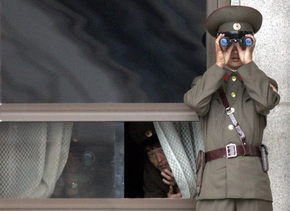Posted on : Nov.2,2006 14:09 KST
Modified on : Nov.3,2006 15:07 KST
 |
|
A North Korean soldier looks through binoculars toward South Korea at Panmunjeom, the truce village bordering North and South Korea, on November 1. AP Yonhap
|
The last round of six-party talks, held in November 2005, got off to an inauspicious start, as North Korea and the U.S. remained at odds over the financial sanctions Washington had imposed on Pyongyang two months prior. As expected, the negotiations ended in stalemate. Over the past year, the six-party talks showed no signs of resumption, with the North and the U.S. failing to find common ground. But somehow, a year later, the stalled talks are about to resume.
The fault lines between the countries involved - the U.S., the two Koreas, China, Japan and Russia - are much the same as they were at the last round of talks. South Korea, Russia and China are pursuing negotiation and dialogue, while Japan and the U.S. prefer hard-line measures such as strong sanctions in order to resolve the issue of the North’s nuclear program.
The multilateral framework has also not been enough to prevent North Korea and the U.S. from confronting one another. The resumption of the talks was solely based on North Korea’s decision, propelled by diplomatic and financial pressure from China and the stronger U.N. sanctions placed upon it after its nuclear test on October 9. The rift between Pyongyang and Washington is also deeper and more complicated than ever after the North’s nuclear test. The talks clearly face a difficult road ahead.
Nevertheless, it is still meaningful that the North and the U.S. have returned to the negotiating table. The two nations made a turnaround in their stances from the previous "crisis avoidance" to "crisis utilization."
Of importance is whether the six-party talks, which are expected to begin this month, could serve as a true negotiating platform with results. At the moment, the outlook remains uncertain, considering the North has merely agreed to cross the threshold of the negotiating room, and this after one year of stalemate. Indeed, the North made clear on Nov. 1 that it decided to return to the six-party talks on condition that Pyongyang and Washington should discuss ways to lift financial sanctions imposed on the communist state. It is the basic U.S. position that the sanctions can be discussed within the framework of the six-party talks. Under current climates, whether the six-party talks proceed is linked to the sanctions issue.
It is still doubtful that the six-party talks could serve as a means to prevent the situation from getting worse, as sanctions and confrontations are being pursued on one side and fragile negotiations are underway on the other side. The threat of war, thrown around just after the North’s nuclear test, has been eased, but nothing has fundamentally changed except that the talks are - once again - about to resume.







